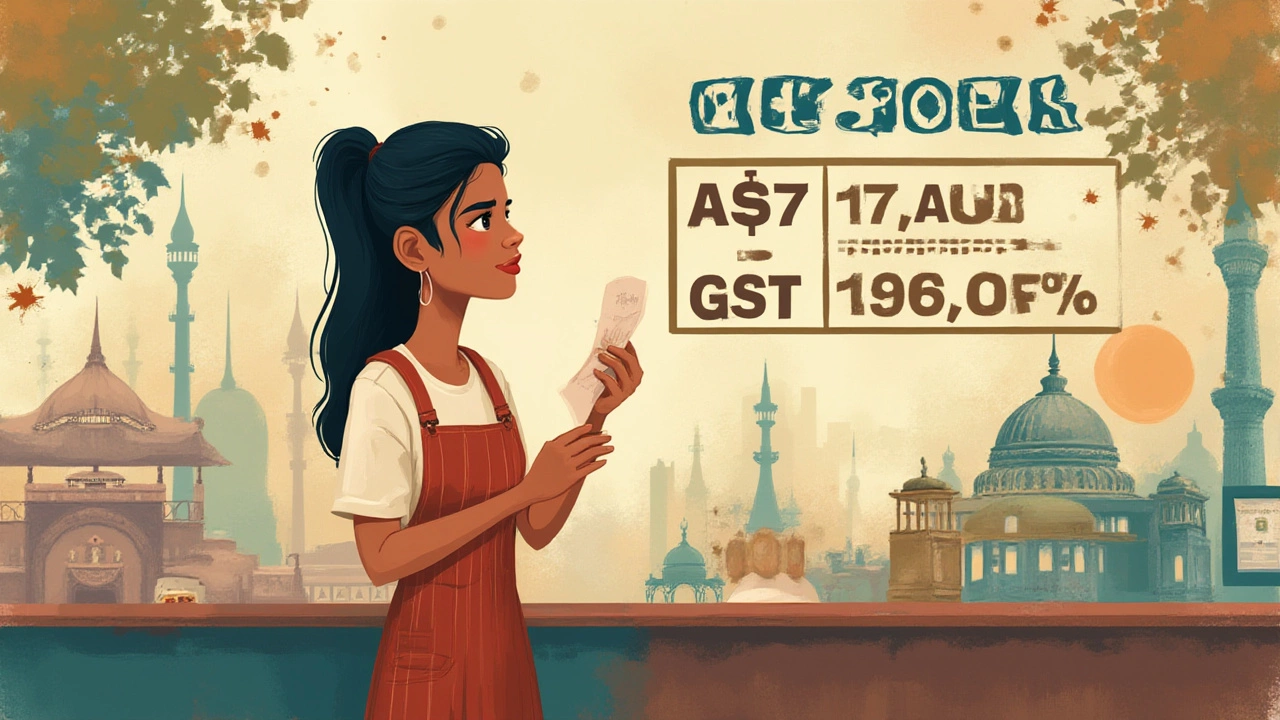 Jul, 21 2025
Jul, 21 2025
The question of whether you need to pay GST can sneak up on you fast, especially if you’re running a side hustle, starting your own gig, or just landed a freelance project that’s actually going somewhere. There’s nothing quite like getting your first big invoice and then freaking out when someone asks, “Is your quote GST inclusive?” The Australian Goods and Services Tax (GST) isn’t just a line on your shopping receipt at Woollies: it’s a maze for anyone running a business, big or small. And, as weird as it sounds, a lot of folks pay it without ever really understanding what sets it off. So, let’s untangle the rules and figure out exactly when you need to pay GST.
What is GST and Who Does It Affect?
GST stands for Goods and Services Tax, and in Australia, it sits at 10%. It’s slapped on nearly everything you buy—unless you’re shopping for things like fresh fruit, basic veggies, or some medicines. But when do you, the business owner or freelancer, have to pay it? It’s not automatic the moment you make $1 at your local market stall. Here’s the kicker: the Australian Taxation Office (ATO) requires businesses and sole traders to register for GST if their annual GST turnover hits $75,000 (or $150,000 for non-profit orgs). Turnover here means the gross income from your business, not your take-home profit, and includes all taxable sales, not just your earnings after you pay expenses.
If you're driving rideshare (Uber, Ola, DiDi, etc.) or a taxi, the rules tighten up even more—you must register for GST from day one, even if you haven’t cracked $75k yet. The ATO loves catching folks out with this one, so if your side gig is ferrying passengers, you basically cannot dodge the GST.
Let’s ground this with a real-life scenario. Imagine you’re running a food truck in Melbourne, selling burgers at festivals and footy matches. You smash it one weekend and think, “Maybe this is the year my food truck goes proper.” If your total sales over 12 months (not your profit) cross $75,000, it’s time to register for GST. Do it late and you’ll pay GST from the point you should have registered anyway, not from when you actually do it—so procrastination here bites back with a bill and maybe even a fine.
How to Calculate GST Turnover and the Most Common Traps
The first headache most business owners face is figuring out what counts towards GST turnover. If you fiddle with numbers a lot, it’s easy to miss the mark. GST turnover is your gross business income—before GST is applied—not your profit. It includes all taxable sales (including online, cash, and card payments). Donations (for non-profits), sales of existing capital assets, and input-taxed sales (things like residential rent or certain financial supplies) don’t count for turnover. But sales to overseas customers do count if you’re registered here.
The ATO uses a rolling 12-month window, not just the financial year. So if business booms in December, it’s not just a problem for your next EOFY paperwork. If you go over $75,000 in any 12-month period, you trigger GST registration. Here’s a quick table for clarity:
| Entity Type | GST Turnover Threshold | Special Rules |
|---|---|---|
| Individuals, Businesses | $75,000 | Rolling 12 months, not just a financial year |
| Non-Profits | $150,000 | Donations don’t count towards threshold |
| Taxi and Rideshare Drivers | nil (must register anytime you start) | Even $1 turnover means you must register |
A fair chunk of small business mistakes come from guessing their turnover, or forgetting that the $75,000 is not the end of financial year sales, but any rolling period. Another trap? Not separating income from hobby vs business. Hobbyists (think of someone selling the odd ceramic bowl at a market once or twice a year) don’t need to worry about GST, but the moment that hobby is more of a proper business, the rules snap into action. So, if you’ve got a second income that’s suddenly going gangbusters, best keep an eye out.
Registering for GST and What Actually Changes
Registering for GST is mostly painless—it’s done online via the ATO’s Business Portal in Australia. You’ll need an Australian Business Number (ABN), which most folks running an enterprise already have. Once you register, you’ll start collecting 10% GST on top of your sales. Just remember: you’re now an unpaid tax collector, holding the ATO’s cash until your quarterly Business Activity Statement (BAS) comes due.
Here’s what changes: your prices probably need an adjustment, since that delicious $10 burger is now $11 if your prices are GST inclusive. Or, at the very least, you need to let customers know if your quoted price includes GST. A lot of customers expect that it does, but business-to-business deals sometimes still talk “plus GST.” Clarity helps you and them.
Every invoice must now include five things:
- The phrase “Tax Invoice” (if the sale is over $82.50 including GST)
- Your ABN
- Date of issue
- Description of items or services sold
- The total price and how much GST is included
You’ll also be able to claim input tax credits, which means getting back the GST you paid on business expenses. Bought a new laptop for work and paid $1,100 ($1,000 + $100 GST)? That $100 comes back to you as an input tax credit. But this only works if the supplier was GST-registered and gave you a tax invoice with the GST listed. For a lot of small businesses, claiming this back can be a helpful cashflow boost, so keep those receipts or use an app to snap and save them on the go.

Exemptions and Special GST Situations
Not every business has to deal with GST, even if they’re quite large. Some sales are “GST-free”—like most fresh food, medical services, and some education courses. That means you don’t add GST, and you can’t claim credits for GST you paid on related expenses. Then there’s “input-taxed” sales (like residential rent and certain financial services), where no GST is added, but you also don’t get those input tax credits. It’s annoying, but those are the rules.
If you’re an online seller, dealing with overseas customers raises more questions. Exported goods and services are generally GST-free, but you still need to be registered and report those sales if you cross the threshold. This applies whether you’re shipping physical products or providing digital services like graphic design or consulting. But if you’re selling to Aussie customers—be it through Shopify or at a weekend market—GST will likely apply.
Some freelancers and contractors try to stay under the threshold, but if you deliberately split your business into two to avoid GST (say, two separate ABNs for two but-actually-one businesses), the ATO can count it all as one. If you’re running a partnership, company or trust, the same $75k rule applies—but you can’t just shuffle income across different entities if the core business is really one operation.
Practical GST Tips and Common Myths—Don’t Get Caught Out
First, get familiar with cash vs accrual accounting. Most small businesses can choose. With cash accounting, you only pay GST when you receive payment, not when you send the invoice. Accrual means you pay GST when the invoice is issued, no matter if the money turns up or not. For anyone chasing slow payers, cash accounting is usually less risky—no one enjoys forking out tax on money that’s still somewhere out there.
Second, if you forget to register when you should’ve—you don’t just owe GST from the day you wake up to your mistake. The ATO will backdate the registration and expect you to cough up GST from when you passed the threshold. No one likes the idea of handing over 10% of their sales (that’s a pile of cash) because they didn’t keep an eye on their numbers. And if you ignore the rules, penalties and interest might follow.
A false myth is that all side hustlers need to register for GST. That’s not true. If you’re mowing your neighbour’s lawn for $50 every other weekend, it’s not a business. But if you level up and have regular clients and advertising, that’s a different kettle of fish, and the $75,000 rule looms.
One more handy point: keep separate business and personal bank accounts. It makes tracking your GST easier, keeping the ATO happy and saving you hours of painful admin at tax time. There are heaps of apps now—Xero, MYOB, QuickBooks—which automate GST calculations and even pre-fill your BAS. If you’re allergic to admin (I am), these are game-changers.
Your GST Checklist—What to Do Next
If you think you might be close to the GST threshold, it’s time to do a quick audit. Tally up your last 12 months’ sales, not profit. If you’re above $75,000, register through the ATO (usually takes a few minutes online). Adjust your prices or at least your invoices so they clearly state whether GST is included or not. Switch to a system (spreadsheet or cloud software) that tracks GST on every sale and purchase.
Here’s a quick checklist:
- Calculate GST turnover from all taxable sales over any rolling 12-month period.
- Register for GST if you cross $75k (or instantly if you’re a taxi/rideshare driver).
- Issue proper tax invoices with the right details.
- Keep every receipt and track your business expenses for input tax credits.
- Report and pay GST every quarter or month via the BAS (ATO will set your schedule).
- Use cash accounting if you want to avoid paying GST before customers pay you.
- Don’t split your business across multiple ABNs to dodge the threshold—the ATO watches for this.
- If you make both GST-free and taxable sales, separate them out to avoid confusion at BAS time.
Staying on top of GST isn’t about loving paperwork, it’s about side-stepping nasty surprises from the ATO. The bureaucracy is never fun, but dodging it isn’t smart. If you do your sums and track your sales, you’ll know exactly when you need to step up and register. Yes, it can feel like a chore. But it’s much better than waking up to a tax bill you didn’t see coming. And if it feels like too much, chatting with a local accountant can save you hours you could spend growing your business—or, you know, just enjoying the Melbourne coffee scene without stressing about the ATO breathing down your neck.